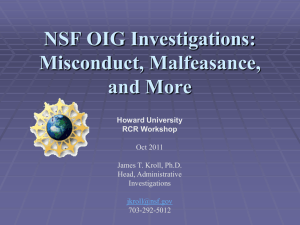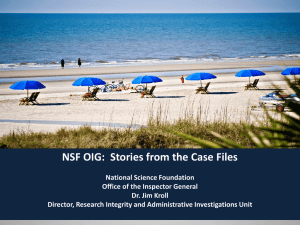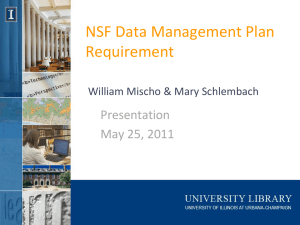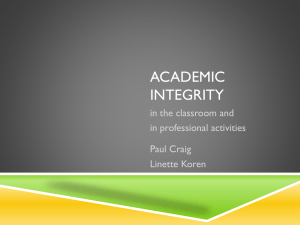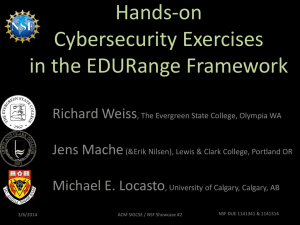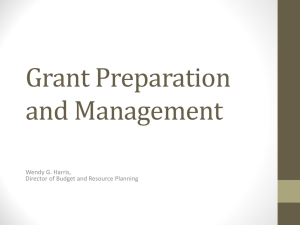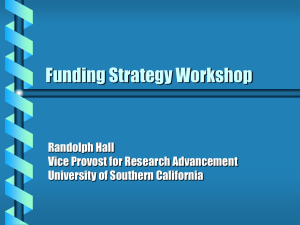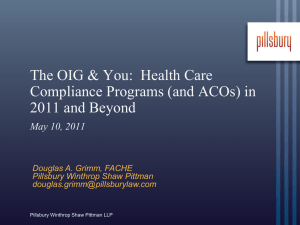NSF OIG Investigations - Howard University, Graduate School
advertisement
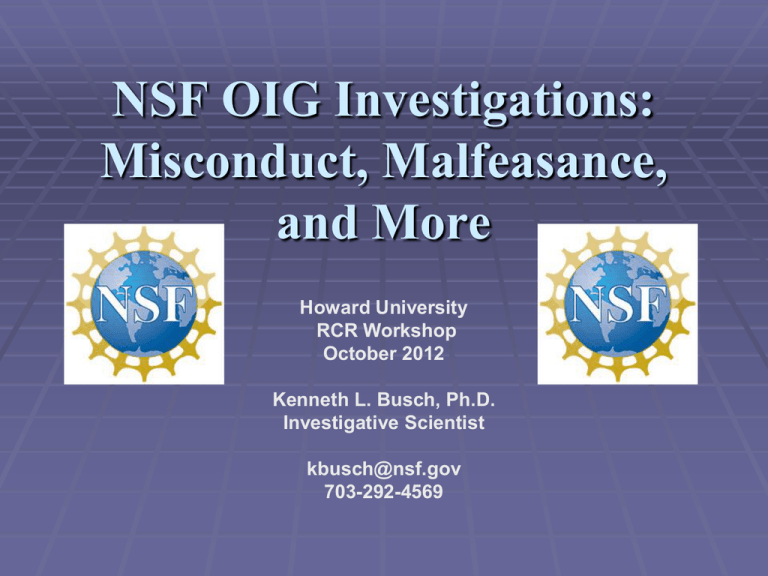
NSF OIG Investigations: Misconduct, Malfeasance, and More Howard University RCR Workshop October 2012 Kenneth L. Busch, Ph.D. Investigative Scientist kbusch@nsf.gov 703-292-4569 Research Misconduct Case Study University notifies us that data submitted in an NSF proposal may have been fabricated The data were from a student conducting survey research Results looked very promising — too promising Mentor submits NSF proposal but then questions student on veracity of data Student suggests that proposal be withdrawn Student claims that data was analyzed by some unknown individual — data exchanges via email Research Misconduct Case Study Unknown person sends an email to mentor stating data are made up, and apologizes. Then the email account is deleted The University investigates and determines that the student made up the data. Student does not defend herself but does not offer up the identity of the “unknown person” Results (after our ROI is sent to NSF) Student dismissed from University NSF debars the student for three years Office of Inspector General (OIG) Almost every federal agency/entity has an IG An IG is an independent office for oversight Promote economy, efficiency, and effectiveness… Prevent and detect fraud, waste, and abuse… …in agency programs and operations NSF OIG 38 audit staff, 22 investigative staff Investigations staff includes: Ph.D. scientists Special agents CPAs Attorneys Tasked with investigating research misconduct allegations Federal Funding Expectations NSF/Federal Gov’t Clear articulation of rules/expectations Balance compliance, institution responsibility and latitude, reduction of bureaucracy Numerous funding opportunities Institution An environment in which employees can operate with integrity Responsible administrative, financial, and research management and oversight (e.g. Article 1, GC-1, OMB Circulars) Principal Investigators Overall -- Uphold ethics and standards of community Submit quality proposals and conduct the funded activity Know and adhere to rules, regulations, and ethics Ensure compliance and education of staff, students What does NSF OIG investigate? The simple answer: Lying Cheating Stealing How does OIG know what to investigate? Allegations received from: Program officers Reviewers Colleagues Students and post-docs University administrators People like you Anyone with an interest in what NSF funds Anonymous We take a general look: Proactive reviews Recurring “problems” What we don’t investigate . . . Generalized QUALITY OF SCIENCE Scientific “divorces” Patent, copyright or programmatic disputes Institutional personnel issues that do not violate statutes, regulations, or grant conditions connected with NSF programs Authorship disputes i.e., Whose name goes on the paper? In what order? Research Misconduct (RM) Federal-wide definition and procedural framework. RM means fabrication, falsification, or plagiarism in proposing or performing research [], reviewing research proposals [] or in reporting research funded by [the agency]. 45 C.F.R. 689.1.a Fabrication: making up data or results and recording or reporting them Falsification: manipulating materials, equipment, or processes, or changing or omitting data or results Plagiarism: appropriation of another person’s ideas, processes, results or words without giving appropriate credit. From 1998-2008, NSF has observed a 3-fold increase in RM allegations Allegations Since 1998 Fold Increase in Number of Allegations 4.5 *Normalized to 1998 research misconduct allegations 4 3.5 3 Misconduct In Science 2.5 2 Research Misconduct 1.5 1 1998 1999 2000 2001 2002 2003 2004 2005 2006 2007 2008 Year Research Misconduct Case Study Master’s Student makes up his entire MS research project Published 3 articles in major journals with two mentors Also published in one conference proceeding Successfully completed his MS oral defense Slipped up in post-defense celebration Claims laziness as an excuse Never really interested in the research University removes student and voids his MS efforts NSF debars him for 5 years Research Misconduct Case Study Post doc allegedly fabricates data in a plant research project Post doc publishes in a major journal Supplementary data posted online Peer researcher reviews research and finds data are questionable—notifies mentor When approached, post doc confesses Only one data set existed – the “replicated” two data sets were simple multiples of original data (.95,1.05) Claims pressure to publish and lack of adequate supplies in laboratory Employment terminated, debarred by NSF Research Misconduct Case Study PI submits proposal w/ copied text and altered figures Amount of text copied was relatively small Figures of cells were taken from a publication by his former mentor Figure caption was altered to represent three fluorescent images that did not accurately describe the image Text in proposal was written to suggest that images were preliminary data collected in his lab University found research misconduct and PI’s employment was terminated NSF finds research misconduct – letter of reprimand; 3 yrs of certifications and assurances Research Misconduct Case Study PI fabricates the existence of two manuscripts in his biographical sketch and makes reference to a nonexistent manuscript in the text of his proposal PI admits that manuscripts did not exist. Showed a pattern of deception about these manuscripts in other scientific proposals submitted to other funding sources Institution finds research misconduct and PI’s employment is terminated NSF makes finding of research misconduct – letter of reprimand and 3 years of certifications Research Misconduct Case Study Allegation that PhD student fabricated work in his dissertation Most work is verifiable……but a small piece is not Mentor files complaint with university Student asks for obscure information Many times refuses to attend hearings regarding the matter In his absence, committee finds that he committed RM Loses degree 3 yrs after it is conferred Loses job as professor at small college Research Misconduct Case Study • PhD student fabricates data in 6 of 16 federally funded research projects • Alters data to better support research hypothesis • Solicits assistance of husband’ to cover up • During investigation, admits to fabrications and commits to assist university in cleaning up fabricated data • Actions/Results • RM finding, 5 year debarment • University removes student from PhD program • Loss of offer to join faculty at Harvard Business School What was the cost of the University investigation? Other Concern Areas Human subject research IRB Animal research IACUC Conflicts of Interest Biohazards Financial Management When Administrative cases turn Civil/Criminal . . . PI submitted SBIR-1 proposal as follow up to his MS Student’s thesis work ($100K, 6 months). PI copied the thesis into his final report and proposal for the SBIR-2 award ($500K). University notifies OIG of plagiarism allegation When awarded, PI used the money to pay his child’s tuition at a University, along with other personal expenses. The PI denied everything. His wife did not. When Administrative cases turn Civil/Criminal . . . NSF suspended the award and OIG issued subpoenas. OIG referred the case to DOJ, which accepted it for prosecution. When Administrative cases turn Civil/Criminal . . . At a meeting with DOJ, the professor (through his attorneys) indicated that he would like to 1) plead guilty to a criminal count (1001) and pay $240,000 restitution 2) avoid jail 3) avoid Federal action against his wife NSF OIG recommended RM finding and debarment. Professor and NSF settled for 3 years voluntary exclusion from Federal funding. Excerpts from the Plagiarism Hall of Excuses It’s only background/introductory material (or it had no technical merit.) It’s only a proposal. It’s not like it’s a publication. The reviewers are smart enough to know what is my work and what is someone else’s. My English teacher told me it’s not plagiarism if I change every seventh word. In my country, this is how we do it. My native language does not have a word for plagiarism. I didn’t do it. My grad student/undergraduate/postdoc/grant writer/faculty colleague/secretary/Co-PI/SRO/AOR/VP of Research/Dean/spouse wrote that section. It’s in the public domain. The pressure of the deadline and the room overheating resulted in my carelessness with my citations. It’s not plagiarism; it’s just bad citation. Your Take-Home Message Research community operates under the assumption that effort is honest and that integrity standards are upheld If you uphold the standards, then you can hold the next generation to the same standards If you lose your professional reputation, it’s hard to recover Federally funded research is a public trust; if not treated as such, consequences are severe Don’t lie. Don’t cheat. Don’t steal Contact Information nsf.gov/oig Hotline:1-800-428-2189 E-mail:oig@nsf.gov Fax:(703) 292-9158 Mail: 4201 Wilson Boulevard Arlington, VA 22230 ATTN: OIG HOTLINE Purchase Card Fraud Purchase (P) Card misuse at a university, Center Accountant - Large volume of purchases from Internet vendors, Vague receipts submitted by the P-Card user, many receipts looked similar, Questionable purchases charged to Federal Grants. Center Accountant resigned after University Auditors asked about internet purchases. Investigation initiated by NSF-OIG Evidence found on the Center Accountant’s Computer E-mails from Internet vendors shipping goods to the employee’s home, Copies of templates for various Internet vendor invoices, One template had been altered 64 times, Personal Pictures of the P-Card User enjoying the good life. Investigative Findings Over 5 year period of time Over 3800 personal purchases made from more than 15 different vendors Over 1900 transactions through the institution’s financial system Over 30 different accounts (NSF/State/Private) fraudulently charged Over $316,000 fraudulently diverted Concealment of Fraudulent Activities Majority of items shipped to home address Lied to supervisors and co-workers Forged the supervisor’s signature on PCard statement review documents Created false invoices Manipulation of the institution’s accounting system How many items were purchased with Grant Funds? By tracking the evidence, we found 20 items purchased with Grant funds. What was really bought DOJ Resolution 22 count Federal Criminal Indictment 17 Counts “Mail Fraud” 5 Counts “Theft from an Organization Receiving Federal Funds” Guilty Plea to all 22 counts Sentenced to: 32 months prison 3 years supervised probation $316,000 Restitution/$2200 fines-assessment 250 hours community service 5 year debarment.
